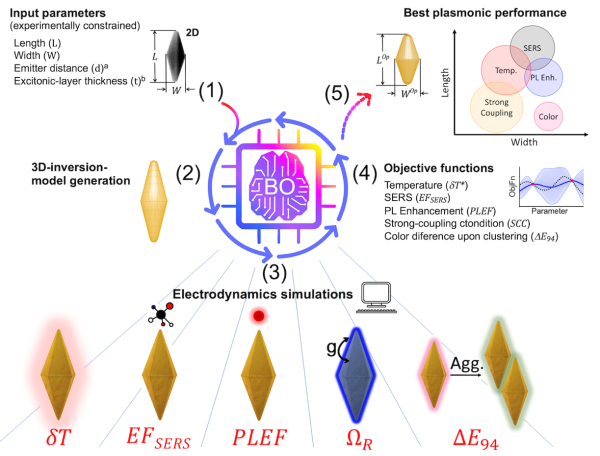Accelerated Design of Gold Nanoparticles with Enhanced Plasmonic Performance
Finding the best structural parameters of gold nanoparticles for targeted applications is a resource-intensive and non-trivial task, even for experienced researchers. AI is becoming an emerging tool capable of accelerating the optimization process of nanomaterials.
In a conventional workflow, one uses the so-called forward design (or trial-and-error processes) in which the manual adjustment of nanoparticle structure is verified by numerical evaluation to assess their performance for targeted applications. An interdisciplinary research team at CFM, led by Marek Grzelczak, has developed a workflow in which a global optimization algorithm (Bayesian Optimization) orchestrates electrodynamic simulations to find the optimal structure of nanoparticles. In this inverse design approach, the plasmonic performance is the objective the algorithm seeks to maximize through a sequential learning and optimization process as it traverses across the multidimensional parameter space (Figure). By using gold bipyramids as a model system, the researchers demonstrated that the self-driving workflow can propose optimal nanoparticle dimensions, resulting in enhanced performance in photothermal heating, SERS, photoluminescence enhancement, strong plexcitonic coupling, and colorimetric sensing. The inverse design workflow has been found to accelerate the canonical forward design by a factor of two orders of magnitude.
The appealing feature of the algorithm is its capability for multi-objective optimization – finding a structural trade-off to balance between antagonistic performances. The researchers could find dimensions of gold bipyramids that maximize photoluminescence enhancement of an emitter while minimizing heat generation. The excessive local heat generation by gold nanoparticles can compromise the photoluminescence of the emitter, holding back the development of devices.
Although used for the design of individual nanoparticles, the workflow is expected to handle equally well the design of large multiparticle systems, thereby informing experimentalists with optimal design rules for targeted applications.

Figure: The autonomous workflow suggests structural parameters for gold bipyramids with maximized plasmonic performance in photo-thermal heating, SERS, photoluminescence enhancement of an emitter, strong plexcitonic coupling, and color transition upon clustering.



